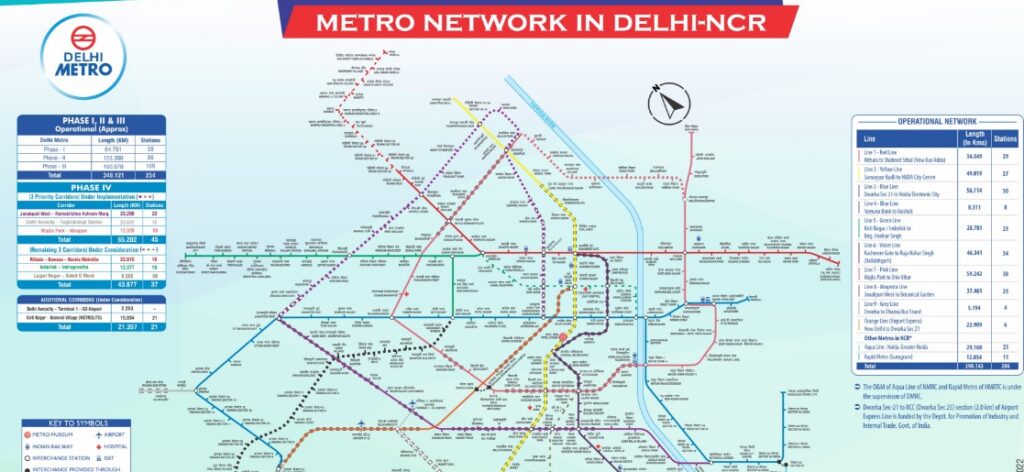The Delhi Metro Blue Line 2025 stands as a vital artery in the city’s transportation network, seamlessly connecting diverse neighborhoods across Delhi, Noida, and Ghaziabad. For an in-depth understanding, explore this comprehensive guide on the Delhi Metro Blue Line 2025.
Delhi Metro Blue Line 2025 Overview
Route Coverage Across Key Urban Zones
The Blue Line stretches from Dwarka Sector 21 in the west to Noida Electronic City in the east. A separate branch extends from Yamuna Bank to Vaishali. Together, these lines connect major residential, commercial, and industrial areas.
Key Interchange Points for Seamless Connectivity
Strategically located interchange stations increase accessibility across the metro network:
- Rajiv Chowk: Intersects with Yellow Line
- Mandi House: Links with Violet Line
- Botanical Garden: Connects to Magenta Line
- Kirti Nagar: Transfers to Green Line
- Janakpuri West: Interchanges with Magenta Line
- Dwarka Sector 21: Connects to Airport Express Line
Station List for Delhi Metro Blue Line 2025
Main Line: Dwarka Sector 21 to Noida Electronic City
This main corridor includes major stations such as:
- Dwarka Sector 21
- Dwarka Sector 8
- Dwarka Sector 9
- Dwarka Sector 10
- Dwarka Sector 11
- Dwarka Sector 12
- Dwarka Sector 13
- Dwarka Sector 14
- Dwarka
- Dwarka Mor
- Nawada
- Uttam Nagar West
- Uttam Nagar East
- Janakpuri West
- Janakpuri East
- Tilak Nagar
- Subhash Nagar
- Tagore Garden
- Rajouri Garden
- Ramesh Nagar
- Moti Nagar
- Kirti Nagar
- Shadipur
- Patel Nagar
- Rajendra Place
- Karol Bagh
- Jhandewalan
- Ramakrishna Ashram Marg
- Rajiv Chowk
- Barakhamba Road
- Mandi House
- Supreme Court
- Indraprastha
- Yamuna Bank
- Akshardham
- Mayur Vihar – I
- Mayur Vihar Extension
- New Ashok Nagar
- Noida Sector 15
- Noida Sector 16
- Noida Sector 18
- Botanical Garden
- Golf Course
- Noida City Centre
- Noida Sector 34
- Noida Sector 52
- Noida Sector 61
- Noida Sector 59
- Noida Sector 62
- Noida Electronic City
Branch Line: Yamuna Bank to Vaishali
This branch line comprises:
- Yamuna Bank
- Laxmi Nagar
- Nirman Vihar
- Preet Vihar
- Karkarduma
- Anand Vihar
- Kaushambi
- Vaishali
Timings and Frequency on the Blue Line
Weekday Operations: Monday to Saturday
- Start: 6:00 AM
- End: 11:00 PM
- Peak Frequency: Every 2 to 5 minutes
- Off-Peak Frequency: Every 7 to 10 minutes
Sunday and Holiday Schedule
- Start: 8:00 AM
- End: 11:00 PM
- Frequency: Every 5 to 15 minutes based on demand
Blue Line Development Plans and Sustainability Goals
Upcoming Expansions to Improve Connectivity
An upcoming extension from Noida Electronic City to Sahibabad will strengthen links with Ghaziabad. The integration with the Regional Rapid Transit System (RRTS) enhances intermodal transportation.
Environmental Responsibility Through Innovation
The Blue Line has earned carbon-neutral status. DMRC employs regenerative braking, solar energy, rainwater harvesting, and solid waste management to cut emissions and promote sustainability.
Benefits of the Blue Line for Commuters
Reducing Travel Time Across Delhi NCR
The Delhi Metro Blue Line 2025 allows faster travel between key points in Delhi, Noida, and Ghaziabad. By eliminating long road commutes, it helps passengers save valuable time every day.
Enhancing Accessibility for All Passengers
With elevators, ramps, and clear signage, Blue Line stations support passengers with disabilities, elderly citizens, and children. These amenities ensure equal access and comfort.
Reliable Service With Minimal Disruptions
Regular maintenance, real-time updates, and high-frequency trains contribute to a consistent experience. Passengers rely on the Blue Line for predictable travel, even during peak hours.
Connecting Commercial Hubs and Institutions
The route passes through educational centers, office zones, retail destinations, and healthcare facilities. Professionals, students, and shoppers benefit from its strategic alignment.
Integration With Other Public Transport Modes
Seamless Transfers to Metro Lines
The Blue Line interfaces with multiple lines, allowing passengers to travel effortlessly across the city. It eliminates the need for separate ticketing or additional travel.
Connection to Buses and Last-Mile Transit
Many stations feature bus terminals, e-rickshaw services, and feeder routes. These last-mile options simplify onward travel from metro stations.
Impact on Traffic and Urban Pollution
The shift from cars to metros reduces traffic congestion and improves air quality. As more people use the Blue Line, Delhi moves toward a greener and more breathable future.
Conclusion
The Delhi Metro Blue Line 2025 sets a benchmark in public transportation by offering wide coverage, reliable timings, and green practices. It empowers daily commuters and contributes to a cleaner, more efficient urban environment.
For further information or inquiries, please contact us.
Frequently Asked Question
1. What is the complete route of Delhi Metro Blue Line 2025?
The Blue Line runs from Dwarka Sector 21 to Noida Electronic City and has a branch from Yamuna Bank to Vaishali, covering key zones in Delhi, Noida, and Ghaziabad.
2. How many stations are there on the Delhi Metro Blue Line in 2025?
The Blue Line includes 50+ stations across its main and branch routes, serving major commercial and residential hubs.
3. What are the first and last train timings on the Blue Line?
Trains usually start at 6:00 AM on weekdays and 8:00 AM on Sundays, with services running until 11:00 PM. Exact timings may vary slightly by station.
4. How frequent are trains on the Delhi Metro Blue Line?
During peak hours, trains arrive every 2–5 minutes, and during non-peak hours, the frequency ranges between 7–10 minutes.
5. Which stations on the Blue Line are interchanging with other metro lines?
Major interchange stations include Rajiv Chowk (Yellow Line), Mandi House (Violet Line), Kirti Nagar (Green Line), Janakpuri West (Magenta Line), and Botanical Garden (Magenta Line).
6. Is the Delhi Metro Blue Line connected to Noida and Ghaziabad?
Yes, the Blue Line connects central Delhi with Noida (Electronic City) and Ghaziabad (Vaishali) through separate line branches.
7. Are all Blue Line stations accessible for people with disabilities?
Yes, most Blue Line stations feature elevators, ramps, tactile paths, and reserved seating to support inclusive commuting.
8. Is there parking available at Blue Line metro stations?
Select stations offer paid parking facilities for two-wheelers and four-wheelers. Availability varies by location.
9. Does the Blue Line connect to the Airport Express Line?
Yes, Dwarka Sector 21 serves as an interchange station for the Airport Express Line, offering direct airport connectivity.
10. Are there any upcoming extensions to the Blue Line?
Yes, a proposed extension from Noida Electronic City to Sahibabad will strengthen the network and improve regional access.






